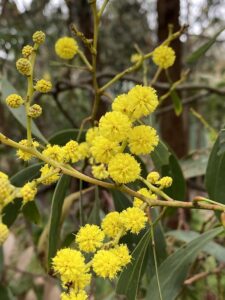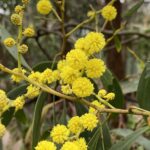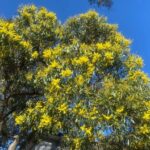Gardening with Indigenous Plants
Indigenous Plant Use
Identification & Control of Common Weeds
| Myth Buster: | Wattles rarely cause hayfever (it is mostly grasses) |
| Botanical Name: | Acacia pycnantha synonym: Racosperma pycnanthum |
| Common Name: | golden wattle |
| Sold As: | Tube ($2.00) |
| Plant Type(s): | Tree (up to 6 m), Large Tree (over 6 m), Bee Attracting, Bird Attracting, Butterfly Attracting, Insect Attracting, Indigenous Plant Use |
| Indigenous Plant Use: | Roasted seeds and gum can be eaten. Bark used as a sedative for rheumatism.CAUTION: Many plants are poisonous if not collected and prepared properly! |
| Growing Conditions: | Full Sun, Partial Shade
Dry, Moist, Well Drained |
| Size (HxW): | 3-10 m x 2-5 m |
| Foliage: | Broad, bright green sickle-shaped to curved foliage to 20 cm x 10-50 mm, often hanging. Single, central main vein, 1-2 glands, slightly raised, near the base of the leaf. |
| Flowers: | Masses of densely-flowered, scented golden ball-shaped flowerheads in axillary spikes. Thin flattish, slightly constricted pods 5-13 cm x 5-7 mm. July-October |
| General Comments: | Floral Emblem of Australia. Specimen plant. Windbreak, screen. Fast-growing legume, drought resistant. Birds like the seeds and insects it attracts. Food plant for caterpillars. |
 Further Information: |
|





